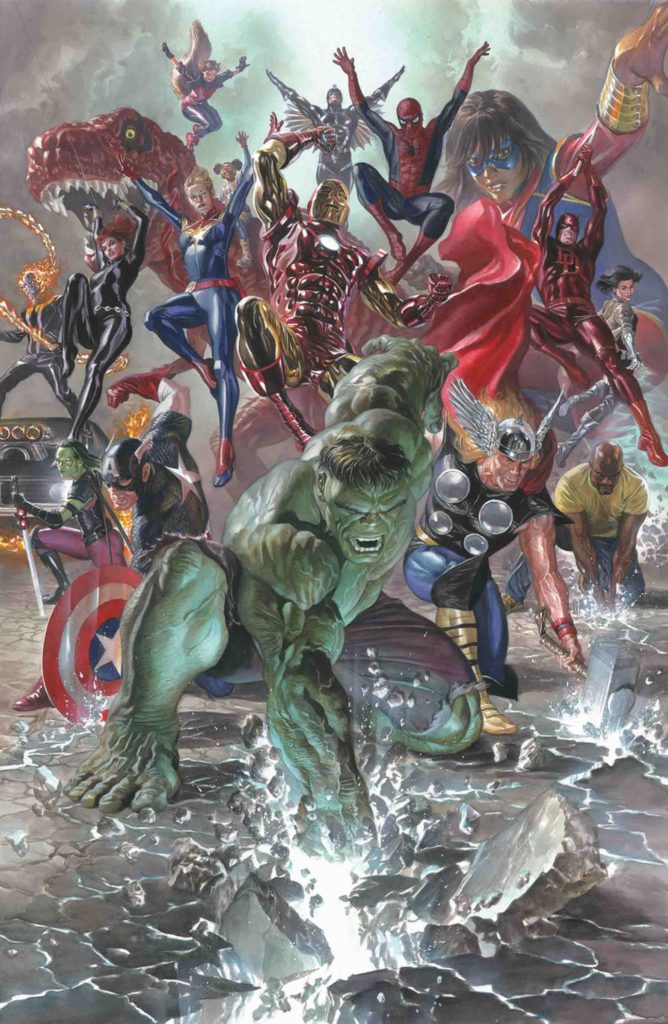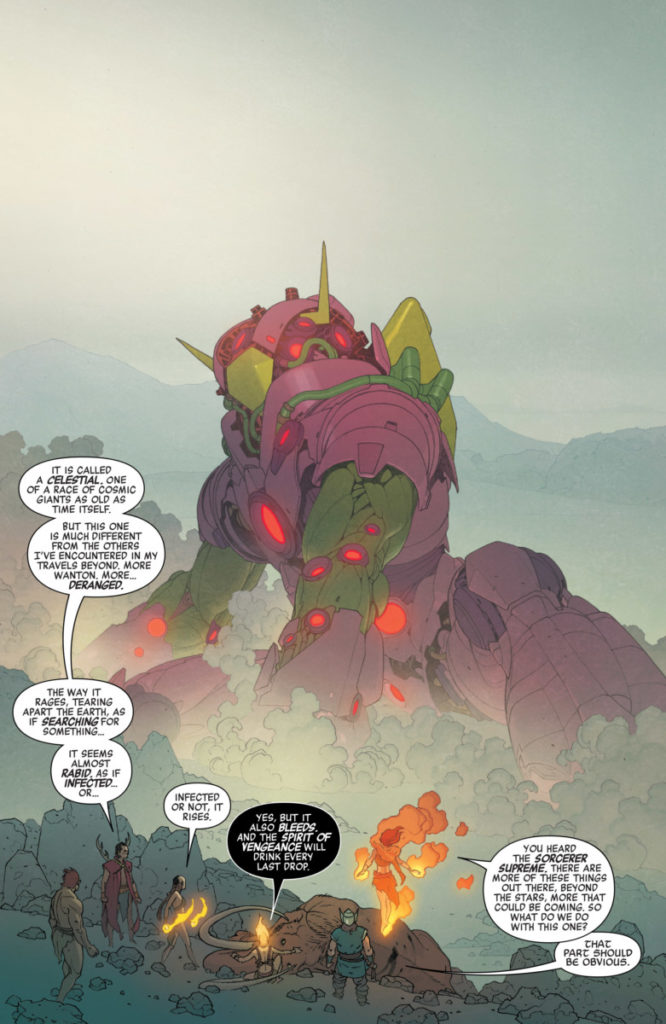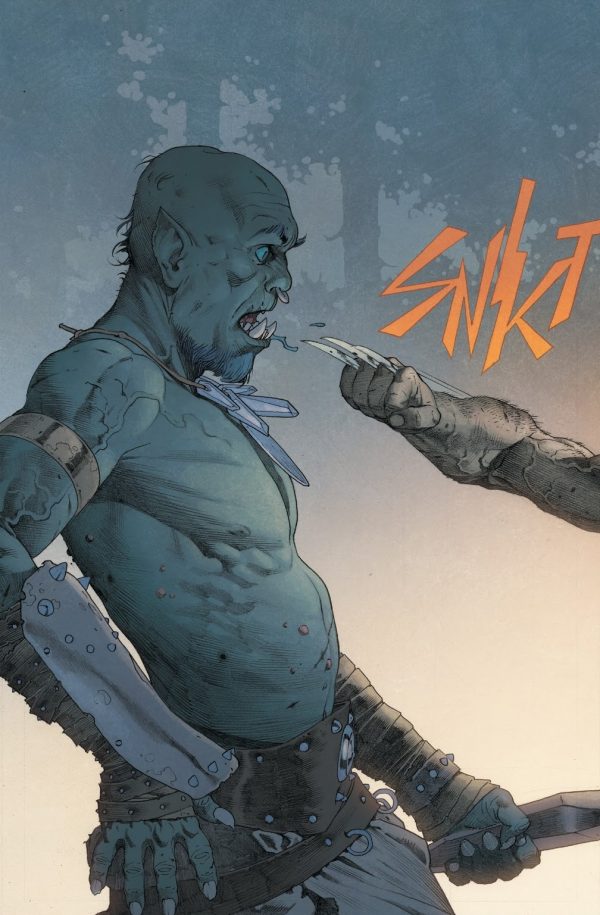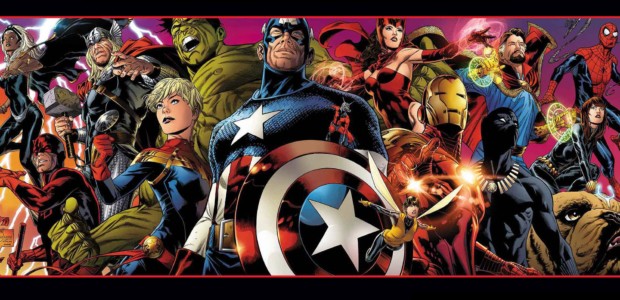
You may as well buckle in, because this one could take awhile —
It doesn’t take a genius to see that Marvel Comics (as opposed to their Hollywood arm, which is really the tail that’s wagging the corporate dog now) is in a bad place these days. Sure, they’re still the number-one publisher on the Diamond sales charts most months, but you should take that as literally as possible — they’re well and truly the number one publisher, as in, they publish the most stuff. They crank out, on average, 20-30 more periodicals per month than their nearest competitor, DC, and therefore they sell more units, and take in more dollars, almost by default. But when you look at things a little bit more closely, the news for Marvel is almost all bad:
For the last several months running, for instance, Marvel hasn’t had a single comic book or trade paperback collection sell over 60,000 copies; the overwhelming majority of their books are selling in the 20,000-30,000 range; each of their much-ballyhooed cross-over “events” for the past four years running has sold in lower numbers than the previous one; once-venerable franchises like Captain America, Iron Man, the X-Men, and the Hulk are having trouble moving 20,000 units per month; it’s been nearly a year since any Marvel book other than the first issue of an “event” has cleared the 100,000 sales threshold; each of Marvel’s last four nearly-annual relaunches has resulted in lower sales, even for the “new” first issues, than the last one.
All of these various trouble signs, concerning as they are, really are just symptoms, though — the “disease” itself is more amorphous, but infinitely more serious: the comic book-reading public just doesn’t seem to like what Marvel is putting out these days, by and large, and the reasons for this are many and varied:
Marvel’s previously-referenced constant re-launches have become tedious in the extreme; the combination of Marvel’s high cover prices and shoddy physical product doesn’t offer good value for money; that incessant stream of cross-overs results in series that people are following and enjoying being hijacked for months at a time, and most readers jump off, rather than on, when that happens and don’t come back; the overwhelming majority of Marvel’s titles feature continuity-heavy, derivative stories, mandated by editorial dictate, that aren’t welcoming to new readers; the quality of the art in most of their books has gone noticeably downhill in recent years; there are more cost-effective ways of following the goings-on at Marvel than buying their printed product, most especially thanks to their Unlimited digital service, which gives consumers access to almost their entire back catalogue for only ten bucks a month, and is now running only six months behind their periodicals. In short, Marvel is actively giving readers plenty of justification to not go down to the LCS and pick up their books.
What may be noticeable to some by dint of its absence on that list is Marvel’s purportedly “progressive” political stance, which a small but vocal (and angry) contingent of fans maintains, armed with plenty of inference but no actual evidence, is driving readers away in droves. I put no credence in this school of “thought” simply because, if handled properly, Marvel’s semi-recent diversification of its line-up could actually bring new readers in, and because those clinging tight to this particular hobby-horse really aren’t seeing the forest for the trees: Marvel Comics exists as an IP farm for Marvel Studios now, and unlike their printed-page counterparts, the silver screen versions of Tony Stark, Steve Rogers, Bruce Banner, Thor and the like actually age, and like it or not, they’re going to need to be replaced at some point. There’s a reason that the new cinematic Spider-Man is purportedly 15 years old, and characters like Riri Williams, the Jane Foster Thor, the Amadeus Cho Hulk, and Kamala Khan have been introduced in the comics with the same logic in mind — they’re here to be long-term replacements for and/or reboots of characters who are getting long in the tooth in the movies. Their introduction has precisely fuck-all to do with a so-called “SJW agenda,” no matter how much the troglodytes who are doing their level best to “port over”the “mind”set of “Gamergate” to the comic book scene may claim otherwise.
That being said, these trolls do represent one more contingent of readers who don’t like the ideas coming from the once-branded house of them, and once you remove their noxious, mouth-foaming racism and sexism from the equation (I know, that’s kind of like saying “if you just ignore that whole slavery thing, the confederacy maybe had a point about local, decentralized government”), their displeasure with Marvel isn’t necessarily all that different to the one being advanced by rational, civilized human beings — namely, that this is a company that has lost its way and doesn’t know how to connect with its readership anymore.
Still, none of this means that all is lost, does it? I mean, about 15 months ago DC was in a pretty similar spot, with nothing outside of Batman selling worth a damn and everyone writing the company’s obituary in advance. Then came DC Universe Rebirth, and yeah, while most of their line has reverted to “New 52”-era sales numbers, for a good few months there, nearly all their books were selling like hotcakes, and a solid half-dozen or so are still selling a lot better than they used to even to this day — and hey, fans generally seem much happier with the direction of their comics (I’m not one of them, but for for our purposes here today, that’s actually and entirely beside the point). Crucially, the company is also back in the “black” in terms of profitability, after spending a couple of years in the “red.”
Now, if you’re Marvel, you’re going to notice this, of course. And if you’re Marvel, you’re also tapped-out in the “new ideas” department, so you’re simply going to try to copy what worked for your competition, given that your own publishing strategy just ain’t working anymore. Enter Marvel Legacy.

Of course, a few wrinkles are necessary in order for Marvel to look like they’re not just completely aping what DC has already done, so to that end they’re reverting, by means of a complex and frankly nonsensical formula, back to “classic” numbering for all their series rather than starting everything over at #1 yet again; they’re keeping all their books at $3.99 rather than knocking the price back a buck; they’re sticking with a monthly publishing schedule for their titles, rather than upping ’em to twice per month; they’re leaving most of the extant creative teams on each series in place, albeit with some notable exceptions.
Still, the message they’re at least trying to send to their readers with Marvel Legacy is more or less the same as that telegraphed by DC Universe Rebirth — “We’re going back to basics and we’re determined to bring you the type of storytelling you love. We admit we kind of got off-track there for a spell, but that ends now. Give us another chance, you won’t regret it.”
But have they really changed their ways? Do they even know how to pull out of their creative and commercial tailspin? I would submit, based on the evidence offered up in Marvel Legacy #1, the “blockbuster” oversized special kicking off this supposed “new” direction, that the answer to both questions appears to be an emphatic “no.”

Again, we’re presented with basically no choice but to refer back to Rebirth. Much as I actively despised that comic and most of what’s followed in its wake, they did a few things right with it: pricing it at $2.99 was clearly a smart move, as was putting the entire project under the supervision of one person. I would have preferred that person to be someone — hell, probably anyone — other than Geoff Johns, and I still and always will despise the idea of bringing the Watchmen into the DCU “proper,” but the notion of an over-arching storyline that allows for each series to go in its own direction while tying back into the main narrative if and when the situation calls for it at least makes good sense on paper, especially when a company is trying to come out of a period that seemed directionless at best, downright misdirected at worst. Marvel seems to be kind of on the fence about the whole centralized narrative thing, though, as Legacy offers up a few different potential avenues for that without seeming to settle on any of them, and on the dollars-and-cents side it probably comes as no surprise that they’ve eschewed the bargain introductory price point altogether, slapping a whopping $5.99 tag on this special (but, hey, it’s a got a big, fancy gatefold cover by Joe Quesada, Kevin Nowlan, and Richard Isanove — featuring mostly characters who don’t appear in the book at all). You know what, though? Those negatives actually fall pretty far down on the list of complaints here.
Let’s look at some of the bigger ones, then, shall we, starting with — who’s in charge here? Okay, yeah, Jason Aaron is the writer of Marvel Legacy #1, but he’s a freelancer, and not even one who’s signed to Marvel exclusively. His job is done here, he’s going back to writing Thor, and whatever comes out of this clearly won’t be based on his, sorry to be grandiose here but, “vision.” But is anything going to come out of this?
That’s actually a very open question. Unlike Rebirth, Marvel clearly isn’t using this as an opportunity to clear the decks — the handful of plotlines that are touched upon here spring more or less directly from stuff already underway in their titles, which leads into another problem: This book isn’t especially welcoming to either new or returning readers. In fact, if you’re “out of the loop” about what’s been going on in the so-called “616 Universe” these days, you’re going to be totally lost here from the jump, and nothing that happens on subsequent pages is designed to pull you back in. We’re basically shown a disconnected series of events involving a small handful of heroes from the point of view of an omniscient narrator who seems to be able to “see” both past and present, as well as to cast his or her gaze into deep space. We start with a brief look-in at the “1,000,000 B.C. Avengers” that Marvel has been hyping in recent weeks/months before cursory visitations serve up various vignettes (how’s that for Stan Lee-style alliteration?) centered on third-tier (at best) characters like Starbrand and the Robbie Reyes Ghost Rider, we’re introduced to what could possibly, I suppose, be (yet another) new Avengers line-up of Riri Williams/Ironheart, the Jane Foster Thor, and the Sam Wilson Captain America (except everyone knows that Sam is going back to being the Falcon next month), we find that Loki’s up to some typical shit with the Frost Giants, and somewhere in the midst of all this we’re asked to give a shit about a mystery crate that’s being cleared out of S.H.I.E.L.D. headquarters — along with everything else, because the organization itself has been dissolved in the wake of Secret Empire.
The contents of said crate lead to what could arguably be labeled as the one “major” revelation this comic has to offer, since a dude driving a beer truck comes upon it after the entire convoy transporting it is overturned, but come on — if there’s one “long-lost” Marvel character who’s probably going to turn up again hauling a load of beer cross-country, who do you think it’s gonna be? Here’s a hint in case you you haven’t figured it out:

Anything else in here that might grab ya, then? Not really. We get a rapid-fire appearance from Ben Grimm and Johnny Storm; there’s a pit-stop at an empty Avengers Mansion, which shows that the statue they keep out in the backyard appears to be different for whatever reason; we learn — and don’t ask me where the fuck this comes from — that Wakanda has established a space-faring, intergalactic empire (I actually read Black Panther every month and this is news to me); Steve Rogers and Deadpool each turn up for a page for reasons that not just escape me but don’t appear to exist; and we find out that in some way, shape, or form the Celestials have something to do with all this (whatever “this” even is), because hey, there are very few Jack Kirby creations remaining that Marvel hasn’t strip-mined for all they’re worth already, so why not one more?
Artists Esad Ribic, Steve McNiven, Chris Samnee, Russell Dauterman, Alex Maleev, Ed McGuinness, Stuart Immonen, Wade Von Grawbadger, Pepe Larraz, Jim Cheung, Daniel Acuna, Greg Land, Jay Leisten, Mike Deodato Jr. and David Marquez (all colored by Matthew Wilson) comprise our “all-star lineup” on the visual side, but the same lack of inspiration that infects the script seems to have made the leap over to them, as well — it all looks fine, sure, but none of it is especially memorable.
Unfortunately, the same is true of the cliffhangers here — what’s in that mystery crate? Why, it’s an Infinity Gem. Yawn. And who does our unseen narrator turn out to be? Why, it’s Valeria Richards, seen traipsing around the universe with her brother, Franklin. Double yawn. And that’s Marvel Legacy #1 in a nutshell.
A less-than-bold prediction before we close this out, then : Marvel’s highly-publicized vow that they’re taking “at least” an 18-month break from cross-over “events” is going to turn out to be bullshit. The Celestials thing, the Infinity Gem thing, the search for Reed and Sue Richards — one, more, or all of these are going to suck everything into their orbit the minute sales begin to lag again (assuming they even get a “bounce” from this). My money’s on any Infinity Gem-centric story, because let’s face it — every time one of these things shows up, a cross-over is never far behind. Those other sub-plots probably won’t prove to be “red herrings,” but they’ll most likely be “localized” into just a few titles. Now, assuming this proves to be an accurate Criswell imitation on my part, that means —
Nothing. Has. Changed. Here. Okay, bringing back the FF and the “real” Logan seems to be a signal that Marvel is ready to integrate Fox-owned cinematic properties back into their printed-page universe, but seriously — that’s my only “take-away” here, and I went into this thing more or less expecting disappointment. In fact, it honestly felt like the entire comics world was resigned to defeat in regards to Marvel Legacy going in, and rumors (possibly originating from Marvel itself) have already begun to circulate that this whole damn thing is just a “stalking horse” for another, bigger re-launch that’s in the planning stages for late 2018.
Normally, of course, I’d be rolling my eyes at this point, and for good reason. We’ve all been down this road way too many times. But in this case, I actually hope the scuttlebutt is true — I freely admit to not being much of a Marvel fan, but without a healthy, robust, and popular Marvel Comics, your local shop and mine are probably finished. We may not like Marvel, but our retailers need them — and if there’s not a second, and better, re-boot in the works at the back end of Legacy, then the days of this publisher, and of the store owners who rely on them, are numbered.
Tags: Alex Maleev, Chris Samnee, Comic Books, Comics, Daniel Acuna, David Marquez, Ed McGuinness, Esad Ribic, Greg Land, Jack Kirby, Jason Aaron, Jay Leisten, Jim Cheung, Joe Quesada, Kevin Nowlan, Marvel Comics, Matthew Wilson, Mike Deodato Jr., Pepe Larraz, Richard Isanove, Russell Dauterman, Steve McNiven, Stuart Immonen, Wade Von Grawbadger



No Comments